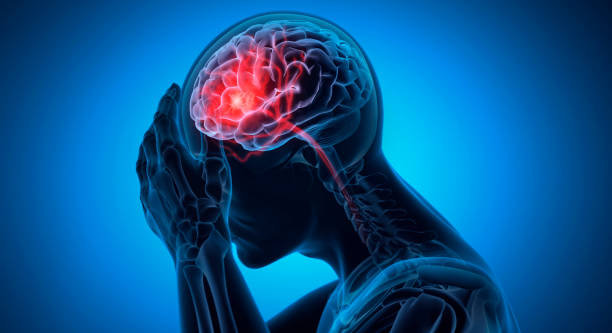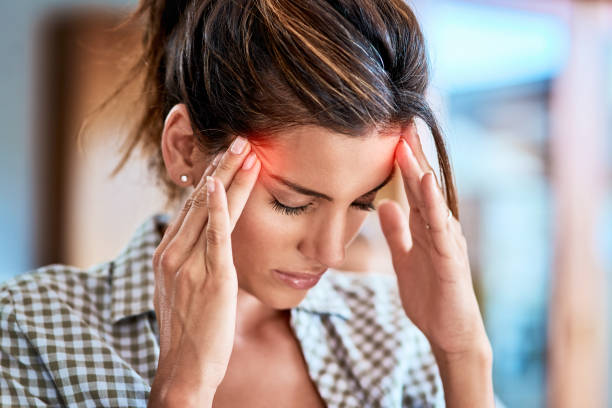Headache is an unpleasant or painful sensation of varying intensity, affecting the entire head or part of it. It can be long-lasting, paroxysmal, dull, sharp, pulsating, bursting. It is observed during migraine, provoked by vascular disorders, injuries, increased intracranial pressure, infections, intoxications and other reasons. The etiology of cephalgia is established on the basis of survey data, neurological examination, hardware and laboratory methods. Treatment is carried out using medications and physiotherapeutic methods. Sometimes surgery is required.

General characteristics
Headache (cephalgia) is widespread. During the year, it occurs at least once in 90% of people. In 95-98% of cases, it develops in the absence of organic pathology. Symptomatic (secondary) Headache can bother people of any age and gender, more often appear in representatives of older age groups, which is associated with the widespread prevalence of vascular pathologies, the presence of previously suffered provoking diseases. The incidence of various primary Headache correlates with the gender of patients.
There are no pain receptors directly in the brain tissues, so the factor causing the occurrence of pain is irritation of adjacent structures: meninges, cranial and spinal nerves, nociceptors in the walls of extracranial vessels, muscles of the head and neck against the background of compression, muscle tension, changes in the tone of arteries and veins, etc. The sources of primary bothers are still not fully tacit. Most experts assume that such Headache develop as a result of complex changes in the nerves and vessels.

Classification
Rare or single cephalalgias that occur due to external influences and do not entail a threat to health are considered physiological. Other variants are considered pathological. Taking into account the presence or absence of provoking diseases, all headaches are divided into primary and secondary. The following causes of secondary cephalalgia are distinguished:
- injuries;
- vascular pathologies;
- nonvascular lesions of intracerebral structures;
- intoxication or withdrawal syndrome;
- infectious diseases ;
- homeostasis disorders;
- diseases of adjacent structures: eyes, ENT organs, etc.;
- neuralgia;
- mental disorders .
Depending on the localization, pain is felt in the entire head, its right or left half, the back of the head, the crown, and the temples. In some cases, the pain syndrome migrates or occurs in one area and then spreads to neighboring areas.
Why does my head hurt?
Physiological reasons
Episodic single or rare Headache may be observed in the following circumstances:
- Stressful situations . Are one of the supreme collective maddening causes. Headache is combined with vivid emotional experiences. Insomnia is possible.
- Weather dependence . The symptom appears when the weather changes or shortly before they begin. Dull, squeezing, painful sensations of weak or moderate intensity are accompanied by dizziness, fatigue, irritability, and fatigue.
- Sexual activity. Pain syndrome is observed mainly in men, can develop during arousal, during orgasm or immediately before it. As a rule, it has a pulsating character. It is caused by increased blood pressure and increased heart rate.

Other possible causes include mental or physical fatigue, hunger, strict diets, drinking large amounts of strong tea and coffee, or, conversely, abruptly stopping drinking caffeinated beverages if you are used to drinking them.
Primary cephalgias
In spite of the lack of an organic base they look as if habitually are often highly intense, impair quality of life, and negatively affect work capacity:
- Migraine . The most common cause of headaches in women of reproductive age. Refers to the category of hemicrania, the right half of the head hurts more often than the left, the side sometimes changes. The epicenter of the pain is in the temple, eye or forehead area. The pain is pressing, pulsating, lasting from several hours to 3 days.
- Cluster headache . It is found in strong young men. One more hemicranias but with predominant localization in the left half of the head. Pain syndrome with the epicenter in the eye socket, extremely intense, unbearable, stabbing, burning or bursting in nature. It is supplemented by vegetative disorders. It lasts from 15 minutes to 3 hours.
- Tension headache . It is found in people of both sexes, provoked by chronic stress, overexertion, depressive disorders. It covers the entire head, tightening, squeezing, dull, aching. It is combined with irritability, anxiety, increased fatigue.
- Hypnic headache . Observed in older people. Develops only in sleep, causes the patient to wake up. Spreads to the entire head or half of it. As a rule, moderate, dull.
Traumatic injuries
Cephalgia accompanies all craniocerebral injuries . The pain is diffuse, can be pressing, bursting, moderate or intense. It intensifies in a standing position and during movements. It is combined with dizziness, nausea, vomiting, neurological disorders. The duration hinge on on the harshness of the damage. With a concussion, the pain persists for 2-3 weeks, with a bruise – 1-2 months or more.

Vascular diseases
The most serious condition causing headache of vascular genesis is hemorrhagic or ischemic stroke . Cephalgia occurs suddenly, accompanied by rapid deterioration of the condition, weakness, nausea, vegetative symptoms. Then paresis, illnesses of notice, talking sicknesses advance. Other pathologies include:
- PNMC . Headaches are the same as before a stroke, but all symptoms disappear within 24 hours.
- Cerebral atherosclerosis . Concerned about pain in the back of the head or diffuse cephalgia during emotional and physical stress, memory loss, sleep deterioration, asthenia.
- Hypertension . The pain is diffuse, pulsating, bursting with the epicenter in the back of the head or forehead.
- Hypotension . Painful sensations are bursting, dull, accompanied by a feeling of heaviness in the head, weakness, dizziness.
- Vegetative-vascular dystonia . Typical are dull squeezing, less often burning bursting pains, combined with numerous vegetative symptoms.
- Vertebrobasilar insufficiency . There is a sharp one-sided pain in the back of the head after awkward movements of the neck with irradiation to the temple, forehead and eye. Falls and autonomic disorders are possible.
- Horton’s disease . The pain syndrome is caused by damage to the temporal artery, localized in the temple area, initially aching, then burning, and increases with talking and chewing.
Nonvascular intracranial lesions
The most common cause of this group of cephalalgias is intracranial hypertension . The discomfort is regular, prolix and more marked in the crown and forehead. With a rapid increase in cerebrospinal fluid pressure, it is intense and progressive; with chronic disorders, it is moderate, dull, wave-like, or constant. Possible provoking conditions include:
- Space-occupying lesions: primary neoplasms, brain metastKases , abscesses, hematomas, cysts.
- Cerebral edema : aseptic and carcinomatous meningitis, aseptic arachnoiditis.
- Liquorodynamic disorders: hydrocephalus of various origins.
In addition, this group includes headaches caused by a decrease in cerebral pressure (with cerebrospinal fluid fistulas, after a spinal puncture), epileptic seizures, and direct compression of the meninges by neoplasms.
Infectious diseases
Headache is caused by the following infectious lesions of cerebral structures:
- Meningitis . More pronounced in the back of the head, spreads throughout the head. Rapidly increases, is supplemented by chills, fever, nausea, vomiting, severe weakness, meningeal symptoms.
- Encephalitis . Follows acutely progresses rapidly covers the all-inclusive head and is combined with unembellished intoxication. Convulsions, reduced realization, and mental complaints are imaginable.
- Brain abscesses . Along with diffuse headache, intoxication is observed. Focal symptoms of varying severity, epileptiform seizures are noted.
- Empyema . Shows for instance cephalgia and undecorated hyperthermia. Nausea, vomiting, meningeal symptoms are observed. Neurological deficit joins in later.
A slight or moderate aching, pressing, prolonged headache may be associated with infectious-toxic syndrome in influenza , acute respiratory viral infections, and other common infections. The causes may also be diseases of the respiratory tract (pneumonia, tracheitis, bronchitis) or the urinary system ( pyelonephritis , glomerulonephritis). Cephalgia is observed in some local purulent processes: abscesses and phlegmon of soft tissues, hidradenitis, carbuncle. Accompany erysipelas of the scalp.
Occipital neuralgia grounds agony in the spinal of the head. It occurs in the form of severe painful paroxysms, most often bothering on one side, radiating to the neck and ears. With trigeminal neuralgia, attacks of intense burning or shooting pain in the temple, spreading to half of the face, are possible. The duration of the paroxysm in both cases ranges from a few seconds to 2 minutes, episodes can be repeated many times during the day.
Intoxication and drug withdrawal
Cephalgia most often develops against the background of the following intoxications:
- Alcohol intake. As a statute, the basis is a hangover . The sting can be trifling, dull or resilient, soft, alive. Sometimes the indicator occurs instantaneously after downing alcohol.
- Food poisoning . Headache is not intense, aching in nature, combined with abdominal pain, nausea, diarrhea.
- Carbon monoxide poisoning . Moderate diffuse aching pain is observed, sometimes in combination with foolishness and lack of criticality towards one’s own behavior.
Psychoactive substances capable of provoking the symptom include nicotine, hashish, cocaine and opiates. Medication overuse headache develops with prolonged use of painkillers. Other drugs capable of causing cephalgia include ergotamine, histamine-containing agents, some hormones, phosphodiesterase inhibitors. Pain syndrome may be observed when estrogens, opiates and other drugs are discontinued.
Homeostasis disorders
A diverse group of pathologies associated with a disruption of the constancy of the internal state of the body: oxygen starvation, overheating, etc. Includes:
- hypoxia, hypercapnia;
- decompression sickness ;
- heat and sun stroke ;
- breathing disorders in sleep apnea ;
- preeclampsia and eclampsia ;
- hypothyroidism, pheochromocytoma ;
- ischemic heart disease .
Pathologies of adjacent structures
Cephalgia may accompany the following diseases of nearby organs and tissues:
- Otolaryngological: frontal sinusitis, pansinusitis , acute otitis media, mastoiditis , Thornwaldt’s cyst, purulent labyrinthitis .
- Ophthalmological: myopia , hyperopia, strabismus, acute glaucoma .
- Dental: dysfunction of the TMJ due to malocclusion, trauma, dental defects, brusqueism, overload of the masticatory muscles.
- Vertebrological: osteochondrosis , intervertebral hernia, spondylosis, spondyloarthrosis .
Mental disorders
Complaints of dull, bursting pain in the head may be presented by patients with hypochondria , anxiety and depressive disorders. Patients with neurasthenia describe their sensations as “compression of the head by a helmet”. In hysteria, the pain syndrome is often unusual in nature and does not fit into the picture of a specific pathology. In patients with severe mental disorders, pain sensations are often unusual, fanciful, strange.
Diagnostics
Neurologists are involved in determining the nature of the pathology . According to indications, consultations with a therapist, infectious disease specialist and other specialists are prescribed. As part of the survey, complaints and life history are clarified, the circumstances of the onset and characteristics of headaches, and the dynamics of the disease development are established. During the external examination, signs of TBI and intoxication syndrome are detected, hypotension or hypertension is detected by measuring blood pressure. To clarify the diagnosis, the following procedures are carried out:
- Neurological examination. The goal is to detect focal neurological symptoms, meningeal symptoms and other manifestations indicating damage to the central nervous system. The doctor examines reflexes, sensitivity and muscle strength, and conducts special tests.
- Radiography. X-ray scrutiny of the skull is prearranged to detect ruptures of the corrupt and vault. If finger impressions and osteoporosis of the back of the sella turcica are detected, it indicates chronic intracranial hypertension. If pathology of the hard structures of the neck is suspected, X-ray of the cervical spine is required .
- EEG . It is performed to assess the functional activity of the brain. It confirms foci of epilepsy activity, makes it possible to suspect volumetric formations (abscesses, tumors, hematomas). If necessary, it is performed with functional tests.
Ultrasonography. Echoencephalography in TBI let slip the being there of displacement of midline arrangements, hydrocephalus, highbrow edema. Duplex examination plus Dopplerography are indicated if there is a suspicion of a vascular nature of cephalgia, they reveal circulatory disorders.
Tomography. CT and MRI of the brain are performed at the final stage of the examination, help to clarify the data obtained during other diagnostic procedures. Allow to evaluate the structure of tissues, detail information about the location and features of focal changes. Can be native and contrast. The second option is recommended for tumors and vascular pathologies.
Lumbar puncture . It is made in case of hydrocephalus, catching and stirring lesions of the intellect, upsetting brain wrong. It confirms an increase or decrease in intracranial pressure, the presence of inflammation and bleeding. According to the data of microscopy and PCR of cerebrospinal fluid, it is possible to study the composition of the puncture, identify pathogens.
Laboratory tests. They are carried out to assess the general condition of the body, diagnose infectious and inflammatory pathologies, atherosclerosis, metabolic disorders, intoxications.
Treatment
Conservative therapy
The therapeutic tactics are determined taking into account the etiology of the headache:
- Primary cephalgia. Combined painkillers, triptans, NSAIDs are recommended. Sedative anodynes are signposted for stark pain. In some cases, therapeutic blockades are effective.
- Vascular pathologies. Treatment of atherosclerosis and arterial hypertension is carried out using hypolipidemic and hypotensive drugs, diuretics, beta-blockers, disaggregants. For VSD and hypotension, adaptogens, antidepressants, tranquilizers, antioxidants, vitamin complexes are prescribed. Acupuncture , massage , hydrotherapy, aromatherapy are used.
- Infectious diseases. Antibiotics are administered parenterally. A symptomatic therapy plan is made taking into account the existing disorders. Solutions are infused , resuscitation measures are performed according to indications, vital functions are supported using artificial ventilation and drugs, and monitoring is performed.
- Intoxications and general infections. In the first case, antidotes are used, in the second, etiopathogenetic remedy is arranged. Patients of both assemblies requirement detoxification procedures: copious drinking, infusion of crystalloid and colloid solutions, enterosorbents, stimulation of diuresis. The list of measures is determined by the patient’s condition.
Neuralgia. The basic drugs are anticonvulsants. The therapy plan is supplemented with antihistamines, microcirculation correctors, antispasmodics. Therapeutic blockades are performed .
Patients with diseases of adjacent structures require treatment with the participation of an otolaryngologist, ophthalmologist or dentist. The program may include analgesics, antibiotics, vasodilators, etc. Patients with tumors are prescribed radiation therapy or chemotherapy .
Surgical treatment
Liable on the present pathology, the following jobs are performed:
ENT diseases: sanitizing intervention on the middle ear, shunting of the tympanic cavity , mKastoidectomy , open and endoscopic versions of polysinusotomy and frontotomy .
Vascular diseases: carotid endarterectomy , creation of extra-intracranial anastomoses , brachiocephalic trunk prosthetics , hematoma removal, ventricular drainage.
Hydrocephalus: removal of neoplasms and abscesses, decompressive craniotomy , external ventricular drainage , various shunting options.
TBI: removal of depressed fractures, decompressive trepanation, minimally invasive and open removal of hematomas.
Neuralgia: stereotactic surgery, microsurgical decompression , radiofrequency destruction.

[…] Self-esteem is violated, which leads to disturbances in the patient’s mental health like headache ,irriation ,isolation and apathy . This state is characterized by refusal to eat & activation of […]
“Diseases not only affect our physical health but also take a toll on mental well-being. It’s important to spread awareness, promote early diagnosis, and support each other in the journey toward recovery. Prevention, education, and compassion can save lives.”